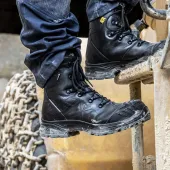Reduce the risk this Love Your Lungs Week
Arco share insights into what businesses need to know to protect their employees’ respiratory health
AN estimated 19,000 new cases of breathing or lung problems were caused or made worse by work annually over the last three years, according to self-reports from the Labour Force Survey. This statistic is entirely preventable if risks are appropriately controlled, say safety specialists Arco, and Love Your Lungs Week (21–27 June) is an ideal opportunity to raise the profile of respiratory health as a serious workplace safety issue.Businesses and organizations must know how to protect staff and provide adequate respiratory protection. Employers have a legal duty to put in place suitable arrangements to manage workplace health and safety, including compliance with the Control of Substances Hazardous to Health Regulations 2002 (COSHH). A considered approach can prevent future deaths and ensure regulatory compliance.
A hazardous substance of particular prominence is respirable crystalline silica (RCS) or silica dust. This is a common by-product of many manufacturing tasks, such as brick and tile manufacture, ceramics, stone working, kitchen worktop manufacture and foundry work, which can all produce airborne silica particles that are invisible to the naked eye.
Inhalation of RCS can cause the development of the following lung diseases:
Silicosis – makes breathing more difficult and increases the risk of lung infections. Silicosis usually follows exposure over many years, but extremely high exposures can lead to rapid ill health
Chronic obstructive pulmonary disease (COPD) – a group of lung diseases, including bronchitis and emphysema, resulting in severe breathlessness, prolonged coughing, and chronic disability. It can be very disabling and is a leading cause of death
Lung cancer – can be caused by heavy and prolonged exposure to RCS dust. When someone already has silicosis, there is an increased risk of lung cancer.
Following a complete risk assessment and recognizing any potential hazards, preventative and protective measures should be implemented. This is highly conditional to the specific work scenario; however, all situations should first consider the possibility of substitution of hazardous materials. The removal of risk is the easiest path to safety. In cases where this is not possible:
Utilize engineering controls to remove or reduce employee exposure. These might be less powerful tools, water systems or an ‘on-tool’ dust-extraction solution
Provide PPE in the form of respiratory protective equipment (RPE). An effective respiratory management programme will ensure correct RPE selection, face-fit testing (for tight fitting RPE), relevant training and regular equipment inspections and maintenance. When selecting types of personal protective equipment, the correct selection of RPE is critical. Experts should be consulted if there is any uncertainty
Carry out regular employee health monitoring to ensure that all control measures are working. Monitoring employees’ health can identify early signs of exposure and can inform updates on current control measures.
As part of a series of toolbox talks, Arco have produced a video on respiratory protection and advice for those working around silica dust.
Following submissions to both consultations by the All-Party Parliamentary Group (APPG) for Respiratory Health, relating to the hazards of silica dust, Arco accepted an invitation to join a panel of industry experts to advise the Government on how to tackle the risks associated with silica dust. Arco’s recommendations were included in the APPG’s updated report, ‘Improving Silicosis Outcomes in the UK’, which was released earlier this year.










